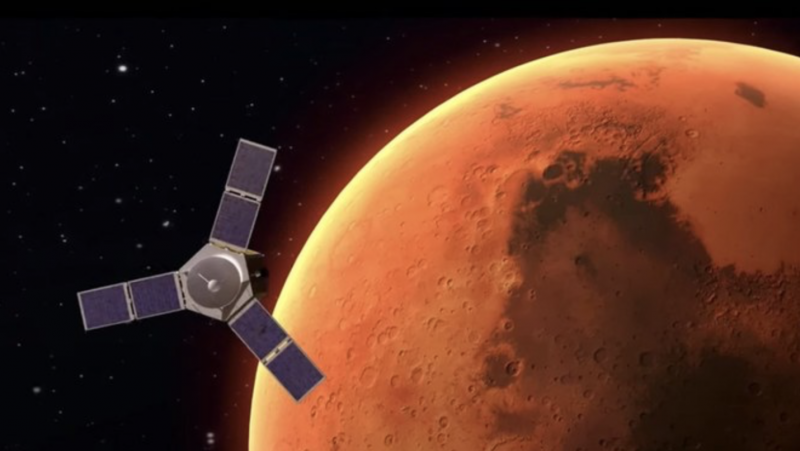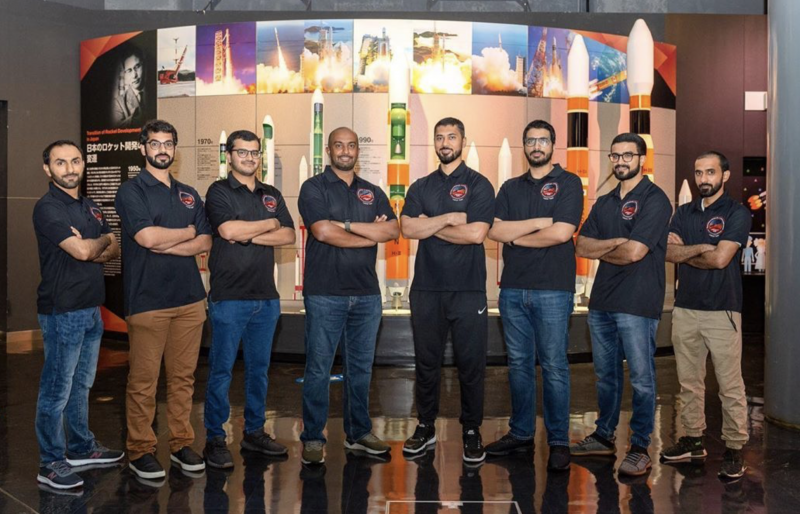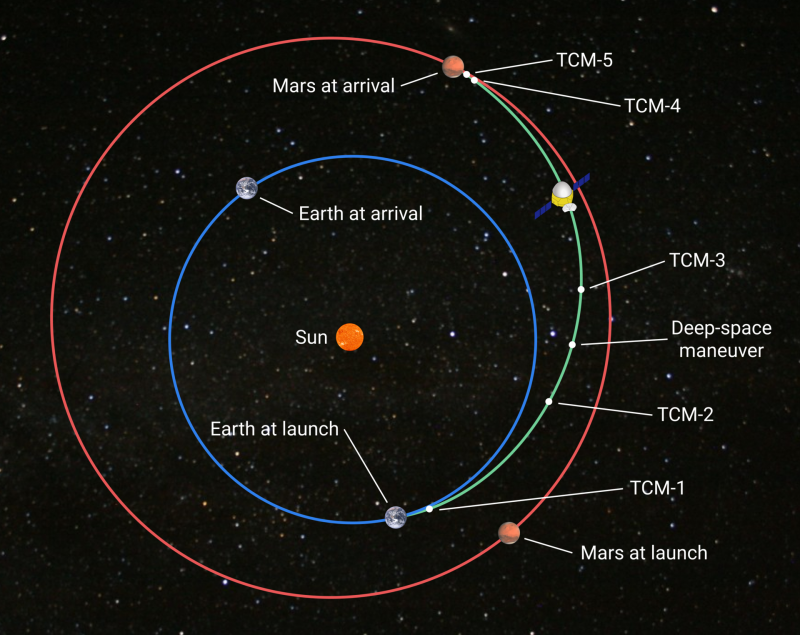

An artist’s depiction of UAE’s Hope Mars Mission orbiting Mars. Image via Mohammed Bin Rashid Space Center.
July 2020 provided a launch window to the planet Mars. That’s why there are three missions slated to arrive at Mars this month, including NASA’s Perseverance, the United Arab Emirates’ first-ever interplanetary mission, called Hope, and China’s first Mars exploration mission, called Tianwen-1. The UAE’s Hope is slated to enter Mars orbit today (February 9, 2021) at 15:30 UTC (9:30 CST; translate UTC to your time). You can watch the approach in real time via the UAE Space Agency website.
Meanwhile, China’s Tianwen-1 craft is also fast approaching Mars and will arrive tomorrow (February 10). NASA’s Perseverance will land on February 18. Both the Chinese and the American missions are robotic – consisting of an orbiter, a lander and a rover – and aim to land on the surface of Mars. The Hope mission will collect its data from orbit.
Read more about Perseverance here
The 2021 lunar calendars are here! Order yours before they’re gone!

View larger. | Infographic showing UAE’s Mars mission Hope, launch to orbit insertion. Image via Mohammed Bin Rashid Space Center.

The Emirates Mars mission Hope probe is roughly as large as an SUV at about 1.5 tons and 10 by 26 feet (3 by 8 meters) with the solar panels extended. Hope will orbit Mars every 55 hours. Image via Mohammed Bin Rashid Space Center.
Hope is the first United Arab Emirates interplanetary mission. If the orbit entry succeeds today, Hope (al-Amal in Arabic) will make the UAE fifth to reach our red neighboring planet, after the United States, India, the former Soviet Union and Europe, via the European Space Agency.
Historically, 50% of the Mars missions have failed. Thus today’s maneuver of the UAE craft Hope – and the upcoming ones – are risky. Today’s orbit entry for Hope requires its six engines to slow the probe from 75,000 mph to 11,000 mph (121,000 kph to 18,000 kph). The maneuver is all preprogrammed, and the mission engineers can only watch to see if all goes as planned.
The science goals of the Emirates Hope mission include studies of the global Martian atmosphere and its upper and lower layers from orbit during two years (one Martian year or 687 days). It will collect data on the lower atmosphere in order to measure climate variations and how weather varies over regions and investigate how the global weather in the lower levels may affect the upper atmosphere.
In particular, the mission will look at how atmospheric gases escape Mars into space over a Martian year, and how that is correlated with the climate variations in the lower atmosphere.
Watch UAE’s Hope mission approach in real time on February 9
Read more about the UAE’s Hope mission to Mars here

A team of space scientists and engineers with the UAE’s Mars mission Hope, via UAE Space Agency.

This 1st image of Mars was captured by the high resolution camera on the Chinese mission Tianwen-1 at a distance of 2.2 million km (1.4 million miles) from the planet, and was released on February 5, 2021. Image via China National Space Administration.
Tianwen-1 is China’s first Mars exploration mission. It is named after an ancient Chinese poem meaning Heavenly Questions. After traveling 292 million miles (470 million km) from Earth, the mission will attempt insertion in a polar orbit around Mars on February 10, 2020.
Tianwen-1 aims to map Mars’ geology and morphology in order to produce surface maps, to look at the composition of the Martian soil and to explore the distribution of Martian water ice. Like Hope, Tianwen-1 will also look at Mars’ atmosphere, in particular the planet’s ionosphere. You can find a long list of Tianwen-1’s mission goals in this article at Nature Astronomy.
About three months after arrival, in May 2021, Tianwen-1’s lander is scheduled to detach from the orbiter. The lander, which carries a rover, will descend to Utopia Planitia on Mars, where one of the earliest Mars explorer missions, Viking 2, touched down in 1976. That area is said to be a relatively safe (but scientifically important) landing site. After touchdown – assuming the landing has been accomplished successfully (and remember, landing on Mars is hard) – the lander will unfurl a ramp for the rover, which will then roll down to Mars’ surface and begin that part of the mission.
As with many Mars missions, including NASA’s Perseverance, Tianwen-1’s overarching goal is to find evidence for past and current life.
These three Mars missions – from the UAE, China and the U.S. – were all launched in a launch window in July 2020, when it would take the least energy to send something off to Mars. That is, Earth and Mars were in the most favorable positions relative to each other for interplanetary travel. A launch window to Mars opens approximately every two years and two months (780 days, to be exact). Mars takes about two years to orbit the sun once (in contrast to one year for Earth) and so Mars is also generally brightest as seen from Earth about every two years, when Earth is passing between the sun and Mars, bringing Mars to opposition in our sky. But the opening of the launch window doesn’t coincide precisely with Mars’ opposition. 2020’s opposition of Mars came on October 13, 2020. The launch window was a few months earlier, in July.
Hope left Earth from Japan on July 19, 2020, Tianwen-1 from China on July 23, and Perseverance one week later from the U.S. state of Florida on July 30.

An illustration of the transfer orbit between Earth and Mars of China’s Tianwen-1 probe and the trajectory correction maneuvers along the way. The orbits of the UAE’s Hope spacecraft and NASA’s Perseversance are similar. Image via Kaynouky/ Wikimedia Commons.
Bottom line: The first of 3 missions to Mars that were all launched in July 2020, the UAE Space Agency’s Hope mission is slated to arrive on February 9, 2021, with the Chinese Tianwen-1 mission planned to enter orbit on February 10 and NASA’s Perseverance to land on February 18.
Source:
https://earthsky.org/space/missions-to-mars-uae-hope-china-tianwen-1